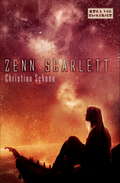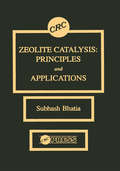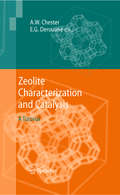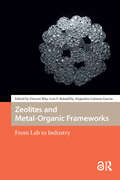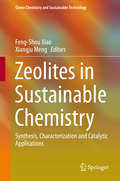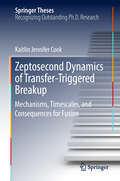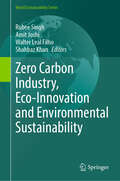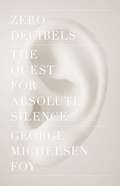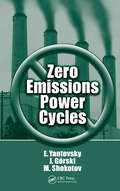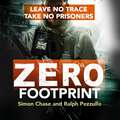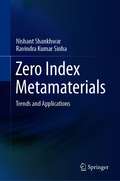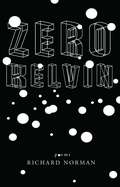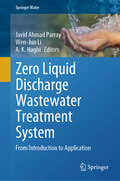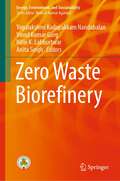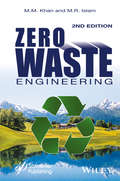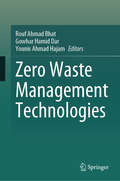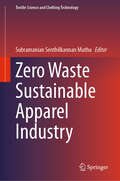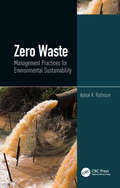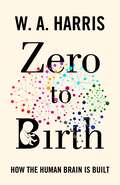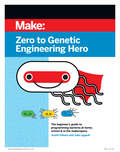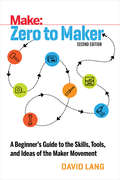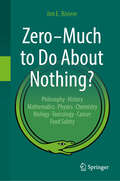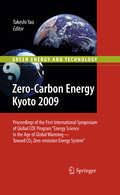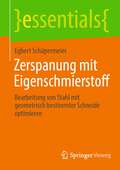- Table View
- List View
Zenn Scarlett
by Christian SchoonZenn Scarlett is a bright, determined, occasionally a-little-too-smart-for-her-own-good 17-year-old girl training hard to become an exoveterinarian. That means she's specializing in the treatment of exotic alien life forms, mostly large and generally dangerous. Her novice year of training at the Ciscan Cloister Exovet Clinic on Mars will find her working with alien patients from whalehounds the size of a hay barn to a baby Kiran Sunkiller, a colossal floating creature that will grow up to carry a whole sky-city on its back.But after a series of inexplicable animal escapes from the school and other near-disasters, the Cloister is in real danger of being shut down by a group of alien-hating officials. If that happens, Zenn knows only too well the grim fate awaiting the creatures she loves.Now, she must unravel the baffling events plaguing her school, before someone is hurt or killed, before everything she cares about is ripped away from her and her family forever. To solve this mystery - and live to tell about it - Zenn will have to put her new exovet skills to work in ways she never imagined, and in the process learn just how powerful compassion and empathy can be.
Zeolite Catalysts: Principles and Applications
by Subhash BhatiaPresented in an easy-to-read form, this book on zeolite catalysis cover all aspects of the subject. It focuses on synthesis, structure, diffusion, deactivation, and industrial applications. This book is an ideal text for courses on catalysis or as a supplementary text for those studying applied or industrial chemistry. It is also a useful resource for anyone who works with zeolites as catalysts in the laboratory, pilot plants, or commercial installations.
Zeolite Characterization and Catalysis
by E. G. Derouane Arthur W. ChesterZeolites have been an important material in catalysis and other applications (adsorbents, detergents) for the last 50 years. While new types of porous materials (ordered mesopores, metal organic frameworks) are now attracting more R&D attention, zeolites are still the most important crystalline industrial catalysts. Zeolite Characterization and Catalysis: A Tutorial makes available a series of tutorials on zeolite characterization and catalysis. Topics covered include X-ray powder diffraction, infra-red and Raman spectroscopy, Electron microscopy, determination of acid/base properties, the important reactions of C1 building blocks over zeolites as well as zeolite catalysis in chemicals . An important chapter covers computational methods in zeolite science. Zeolite Characterization and Catalysis: A Tutorial is intended for graduate students, post-docs and experienced scientists entering the fields of synthesis, characterization and catalytic applications of porous materials.
Zeolites and Metal-Organic Frameworks: From Lab to Industry (Atlantis Advances in Nanotechnology, Material Science and Energy Technologies)
by Vincent Blay Luis F. Bobadilla Alejandro Cabrera GarcíaZeolites are natural or synthetic materials with porous chemical structures that are valuable due to their absorptive and catalytic qualities. Metal-Organic Frameworks (MOFs) are manmade organometallic polymers with similar porous structures. This introductory book, with contributions from top-class researchers from all around the world, examines these materials and explains the different synthetic routes available to prepare zeolites and MOFs. The book also highlights how the substances are similar yet different and how they are used by science and industry in situations ranging from fueling cars to producing drugs.
Zeolites in Sustainable Chemistry
by Feng-Shou Xiao Xiangju MengThis book is devoted to the new development of zeolitic catalysts with an emphasis on new strategies for the preparation of zeolites, novel techniques for their characterization and emerging applications of zeolites as catalysts for sustainable chemistry, especially in the fields of energy, biomass conversion and environmental protection. Over the years, energy and the environment have become the most important global issues, while zeolitic catalysts play important roles in addressing them. With individual chapters written by leading experts, this book offers an essential reference work for researchers and professionals in both academia and industry. Feng-Shou Xiao is a Professor at the Department of Chemistry, Zhejiang University, China. Xiangju Meng is an Associate Professor at the Department of Chemistry, Zhejiang University, China.
Zeptosecond Dynamics of Transfer‐Triggered Breakup: Mechanisms, Timescales, And Consequences For Fusion (Springer Theses)
by Kaitlin Jennifer CookCombining incisive experiments with the latest theoretical advances, this book presents an extensive study of transfer-triggered breakup, the dominant process by which breakup occurs in reactions involving light, weakly bound nuclei. It demonstrates not only that lifetimes of resonant states shorter than a zeptosecond are crucially important for these reactions to suppress complete fusion, but also that such short lifetimes are experimentally accessible. By making quantitative predictions of the effect of breakup from short-lived resonant states on incomplete fusion at above-barrier energies, the book suggests that the extent to which near-target breakup can suppress complete fusion is much more limited than previously thought. With an impressive amount of complex data and state-of-the-art models, which were developed, modified, and tested over course of the Ph.D., it examines all aspects of nuclear reactions – nuclear models, modern detectors and spectrometers, as well as data analysis, and offers a detailed discussion of experimental results and technical developments like new radioactive beams. This excellent and beautifully written book presents outstanding quality experimental work that establishes a cornerstone in our understanding of the reaction dynamics of light weakly bound nuclei at energies around the Coulomb barrier.
Zero Carbon Industry, Eco-Innovation and Environmental Sustainability (World Sustainability Series)
by Walter Leal Filho Shahbaz Khan Amit Joshi Rubee SinghThis book provides the latest research on zero carbon industry and its practical implications for eco-innovation and environmental sustainability for businesses in current scenario. In a zero-carbon industry, there would be profound, sometimes disruptive, changes in our economy compared to our current one. As the world approaches zero carbon industry by 2050, economic output will shift progressively (and permanently) toward those goods and services that do not emit greenhouse gases. Changes in these dynamics would ripple along entire value chains, transforming industries. Creating a zero-carbon industry will require fundamental changes in both our economies and societies. Taking eco-innovation and environmental sustainability seriously will be crucial to businesses, and companies are increasingly keen to signal this commitment. This book aims to illustrate a detailed exploration of the complex and interconnected domains of zero carbon industry, eco-innovation, and environmental sustainability. In addition to combining the academic expertise of emerging and established scholars from different academic fields, this book provides an integrated understanding of the topic on zero carbon emissions, eco-innovation, and environmental sustainability from a broader perspective by combining the work of established and emerging scholars. There is a need to fundamentally transform the zero carbon industry, eco-innovation ecosystem in order to achieve sustainability through the implementation of Industry 4.0 technologies such as artificial intelligence, Internet of things, blockchain, and cloud technologies. The book sheds light on various advancements in zero carbon industry, eco-innovation, and emerging technologies for the purpose of sustainability, and it aims to address the urgency of responding to the UN Sustainable Development Goals (UN-SDGs) as part of the global mandate.
Zero Decibels
by George M FoyHave our noise-soaked lives driven us mad? And is absolute silence an impossible goal--or the one thing that can save us? A lively tale of one man's quest to find the grail of total quiet.---" I don't know at what point noise became intolerable for me," George Michelsen Foy writes as he recalls standing on a subway platform in Manhattan, hands clamped firmly over his ears, face contorted in pain. But only then does Foy realize how overwhelmed he is by the city's noise and vow to seek out absolute silence, if such an absence of sound can be discovered.Foy begins his quest by carrying a pocket-sized decibel meter to measure sound levels in the areas he frequents most--the subway, the local café, different rooms of his apartment--as well as the places he visits that inform his search, including the Parisian catacombs, Joseph Pulitzer's "silent vault," the snowy expanses of the Berkshires, and a giant nickel mine in Canada, where he travels more than a mile underground to escape all human-made sound. Along the way, Foy experiments with noise-canceling headphones, floatation tanks, and silent meditation before he finally tackles a Minnesota laboratory's anechoic chamber that the Guinness Book of World Records calls "the quietest place on earth," and where no one has ever endured even forty-five minutes alone in its pitch-black interior before finding the silence intolerable.Drawing on history, science, journalistic reportage, philosophy, religion, and personal memory, as well as conversations with experts in various fields whom he meets during his odyssey, Foy finds answers to his questions: How does one define silence? Did human beings ever experience silence in their early history? What is the relationship between noise and space? What are the implications of silence and our need for it--physically, mentally, emotionally, politically? Does absolute silenceactually exist? If so, do we really want to hear it? And if we do hear it, what does it mean to us?According to the Environmental Protection Agency, 30 million Americans suffer from environment-related deafness in today's digital age of pervasive sound and sensory overload. Roughly the same number suffer from tinnitus, a condition, also environmentally related, that makes silence impossible in even the quietest places. In this respect, Foy's quest for silence represents more than a simple psychological inquiry; both his queries and his findings help to answer the question "How can we live saner, healthier lives today?"Innovative, perceptive, and delightfully written, Zero Decibels will surely change how we perceive and appreciate the soundscape of our lives.
Zero Degrees: Geographies of the Prime Meridian
by Charles W. WithersCharles Withers explains how the choice of Greenwich to mark 0° longitude solved problems of global measurement that had engaged geographers, astronomers, and mariners since ancient times. This history is a testament to the power of maps, the challenges of global measurement, and the role of scientific authority in creating the modern world.
Zero Emissions Power Cycles
by Evgeny Yantovsky J. Gorski Mykola ShokotovFocusing on fossil-fueled, nonpolluting power generation systems, Zero Emissions Power Cycles presents alternative solutions to the severe emissions problems of power plants. Along with a description of new thermodynamic cycles and the results of computational analyses, this volume provides modern analytical tools and equations to evaluate exergy a
Zero Footprint: The true story of a private military contractor's secret wars in the world's most dangerous places
by Simon ChaseSimon Chase's life is a maze of burner phones, encrypted emails, secret meetings, and weaponry - all devoted to executing missions too sensitive for government acknowledgement. Working for shadowy British and American organisations, Chase has been on the trail of Bin Laden in Afghanistan, protected allied generals in Iraq, and been part of an operation directly related to the attack in 2012 on the US consulate in Benghazi.Zero Footprint takes us to this dangerous and thrilling world, and tells the true story of a private military contractor whose work forms the foundation for western security abroad, especially when the UK and US military, intelligence agencies, and departments of state need something done that they can't - or won't - do themselves.
Zero Index Metamaterials: Trends and Applications
by Nishant Shankhwar Ravindra Kumar SinhaThis book presents the emerging regime of zero refractive index photonics, involving metamaterials that exhibit effectively zero refractive index. Metamaterials are artificial structures whose optical properties can be tailored at will. With metamaterials, intriguing and spellbinding phenomena like negative refraction and electromagnetic cloaking could be realized, which otherwise seem unnatural or straight out of science fiction. Zero index metamaterials are also seen as a means of boosting nonlinear properties and are believed to have strong prospects for being useful in nonlinear optical applications. In summary, this book highlights almost everything currently available on zero index metamaterials and is useful for professionally interested and motivated readers.
Zero Kelvin
by Richard NormanPresent-day astronomy, vast, complex, is looking through darkness to distant objects and times. Yet its discoveries aren't exclusively scientific: from the moons of Pluto to the Doppler effect, the night sky screens a place where math meets myth. Now, in Zero Kelvin, in scenes that shift from the mountains of Goma to the mountains of the moon, from galaxies that feast upon their neighbours to a solar sail unfurling above Earth's orbit, Richard Norman's poetry probes both newly glimpsed corners of the universe, and the myths which bring them into focus. Experiment. It is a human urge-to orbit backwards at great speed.Experimentally, you do itand then the crack of lightning, the open-ended snowflake, splits the sky. Just as the sculptor cut the fat off space,you going backwards renders time. Seconds drop like filings when a magnet is turned off.
Zero Liquid Discharge Wastewater Treatment System: From Introduction to Application (Springer Water)
by Javid Ahmad Parray Wen-Jun Li A. K. HaghiA Zero Liquid Discharge System (ZLDS) is a process that recovers water and solvents from wastewater. The remaining constituents are dehydrated to form pure water, resulting in zero waste. This book is a unique research-oriented guide covering the entire zero-liquid discharge process, from its introduction to its application. Zero liquid discharge water treatment plants require high engineering expertise and careful planning to achieve zero shots. Although it is an efficient wastewater treatment technique, improper industrial wastewater disposal can lead to environmental hazards such as water and soil pollution. This book focuses on ecological degradation and delves deeply into the consequences of improper industrial wastewater disposal, highlighting its effects on water pollution, ecosystem imbalance, and risks to human health. It offers a detailed examination of the resulting contamination and its far-reaching implications, emphasizing the need for proper disposal methods. One of the most critical needs for a healthy life is to provide healthy water and contaminants to be taken from the public water supplies. The book may reflect the healthy situation in many by presenting best practices, aiming to foster an understanding of the role of chemical contaminants in water systems in mitigating environmental hazards and the application of "zero liquid discharge technology" in detail. As industrial pollution continues to rise, there is a need to explore practical ways of managing industrial residues from wastewater. This book presents innovative research on using a "zero liquid discharge system" to achieve this locally and internationally. It also examines appropriate resource management strategies to address environmental concerns. This book critically reviews the health effects of industrial chemicals in the water supply. It examines current frameworks' limitations, challenges, and opportunities and discusses the benefits of using a "zero liquid discharge system" and their impact on global sustainability. The book also emphasizes this technology to limit toxic industrial material utilization. This chapter provides an overview of the occurrence of industrial chemicals in drinking water and the associated human health risks. This book also analyzes existing policies related to industrial wastewater and proposes policy recommendations for effective wastewater management using a zero-liquid discharge system. It discusses implementation strategies and policy adoption, emphasizing the role of policy in shaping and improving industrial wastewater management frameworks. The edited volume aims to highlight the critical operating factors and consider the large capital investments of this system and the operational costs. However, in this research-oriented book, the readers will clearly understand that this novel system can leave behind a dry sludge containing high concentrations of hazardous chemicals and heavy metals. This edited volume will show that the application of a Zero Liquid Discharge System (ZLDS) requires careful planning and analysis.
Zero Waste Biorefinery (Energy, Environment, and Sustainability)
by Anita Singh Nitin K. Labhsetwar Yogalakshmi Kadapakkam Nandabalan Vinod Kumar GargThis book is a compilation of process, technologies and value added products such as high value biochemicals and biofuels produced from different waste biorefineries. The book is sectioned into four categories providing a comprehensive outlook about zero waste biorefinery and technologies associated with it. The emerging technologies that potentially put back the lignocellulosic waste, municipal solid waste and food waste into intrinsic recycling for production of high value biochemicals and bioenergy, along with associated challenges and opportunities are also included. The content also focuses on algal biorefineries leading to sustainable circular economy through production of broad spectrum of bioactive compounds, bioethanol, biobutanol, biohydrogen, biodiesel through integrated biorefinery approach. The volume also includes chapters on conversion technologies and mathematical models applied for process optimization. A sound foundation about the underlying principles of biorefineries and a up-to-date state-of-the-art based overview on the latest advances in terms of scientific knowledge, techno-economic developments and life cycle assessment methodologies of integrated waste biorefinery is provided. This volume will be of great interest to professionals, post-graduate students and policy makers involved in waste management, biorefineries, circular economy and sustainable development.
Zero Waste Engineering: A New Era of Sustainable Technology Development (Wiley-Scrivener #82)
by M. R. Islam M. M. KhanIs "zero waste engineering" possible? This book outlines how to achieve zero waste engineering, following natural pathways that are truly sustainable. Using methods that have been developed in various areas for sustainability purposes, such as new mathematical models, recyclable material selection, and renewable energy, the authors probe the principles of zero waste engineering and how it can be applied to construction, energy production, and many other areas of engineering. This groundbreaking new volume: Explores new scientific principles on which sustainability and zero waste engineering can be based Presents new models for energy efficiency, cooling processes, and natural chemical and material selection in industrial applications and business Explains how "green buildings" and "green homes" can be efficiently built and operated with zero waste Offers case histories and successful experiments in sustainability and zero-waste engineering Ideal for: Engineers and scientists of all industries, including the energy industry, construction, the process industries, and manufacturing. Chemical engineers, mechanical engineers, electrical engineers, petroleum engineers, process engineers, civil engineers, and many other types of engineers would all benefit from reading this exciting new volume.
Zero Waste Management Technologies
by Rouf Ahmad Bhat Gowhar Hamid Dar Younis Ahmad HajamThis volume highlights cutting-edge research on Zero waste management and the associated effects of waste on the environment. Predominantly, it focuses on the challenges of dealing with the amassed production of waste and the cumulative impact of increasing waste on the biosphere. Different sections of this book focus on the comprehensive overview of the technological advancements driving the Zero Waste movement. Furthermore, it explores innovations in waste reduction, recycling, and repurposing, from a global perspective, examining the diverse cultural, social, and economic factors influencing the adoption of zero waste strategies worldwide. In addition, it discusses the challenges, and opportunities inherent in promoting a unified global effort toward sustainable resource management. Discover the latest breakthroughs in waste reduction, recycling, and resource optimization. This essential guide empowers you to implement practical, innovative solutions for a greener future. Whether abusiness owner, environmental enthusiast, or simply curious about sustainable living, this book is a roadmap to a cleaner and healthier planet.
Zero Waste Sustainable Apparel Industry (Textile Science and Clothing Technology)
by Subramanian Senthilkannan MuthuThis book offers a variety of cases offering insights into waste assessment and moving towards zero waste in the apparel industry. In an industry as large and widespread as apparel, efforts toward sustainability and waste reduction are critical. The chapters here cover a variety of topics related to apparel sustainability, including management approaches, circular economy methods, and case studies that academics, students, and professionals in this industry can use to continue to strive toward a sustainable future.
Zero Waste: Management Practices for Environmental Sustainability
by Ashok K. RathoureZero Waste: Management Practices for Environmental Sustainability presents approaches for resource management centered on reducing waste and reusing and recycling materials. It aims to save energy by reducing energy consumption associated with extracting, processing, and transporting raw materials and waste, and also to reduce and eventually eliminate the need for landfills and incinerators. This book presents the various principles, methods, and tools that can be used to address different issues in the areas of industrial waste reduction and sustainability. It examines how to eliminate waste at the source and at all points of a supply chain, and how to shift from the current one-way linear resource model to a sustainable "closed-loop" system. Proposes strategies for businesses to reduce and reuse waste with a goal of reaching a zero waste status. Focuses on how mitigating waste and promoting recycling can save vast amounts of energy. Explains how the zero waste approach would be a key measure to ensure environmental sustainability and help to offset global climate change.
Zero to Birth: How the Human Brain Is Built
by William A. HarrisA revelatory tale of how the human brain develops, from conception to birth and beyondBy the time a baby is born, its brain is equipped with billions of intricately crafted neurons wired together through trillions of interconnections to form a compact and breathtakingly efficient supercomputer. Zero to Birth takes you on an extraordinary journey to the very edge of creation, from the moment of an egg’s fertilization through each step of a human brain’s development in the womb—and even a little beyond.As pioneering experimental neurobiologist W. A. Harris guides you through the process of how the brain is built, he takes up the biggest questions that scientists have asked about the developing brain, describing many of the thrilling discoveries that were foundational to our current understanding. He weaves in a remarkable evolutionary story that begins billions of years ago in the Proterozoic eon, when multicellular animals first emerged from single-cell organisms, and reveals how the growth of a fetal brain over nine months reflects the brain’s evolution through the ages. Our brains have much in common with those of other animals, and Harris offers an illuminating look at how comparative animal studies have been crucial to understanding what makes a human brain human.An unforgettable chronicle of one of nature’s greatest achievements, Zero to Birth describes how the brain’s incredible feat of orchestrated growth ensures that every brain is unique, and how breakthroughs at the frontiers of science are helping us to decode many traits that only reveal themselves later in life.
Zero to Genetic Engineering Hero: The beginner's guide to programming bacteria at home, school, & in the makerspace
by Justin Pahara Julie LegaultZero to Genetic Engineering Hero is made to provide you with a first glimpse of the inner-workings of a cell. It further focuses on skill-building for genetic engineering and the Biology-as-a-Technology mindset (BAAT). This book is designed and written for hands-on learners who have little knowledge of biology or genetic engineering. This book focuses on the reader mastering the necessary skills of genetic engineering while learning about cells and how they function. The goal of this book is to take you from no prior biology and genetic engineering knowledge toward a basic understanding of how a cell functions, and how they are engineered, all while building the skills needed to do so.
Zero to Maker: A Beginner's Guide to the Skills, Tools, and Ideas of the Maker Movement
by David LangZero to Maker is part memoir and part how-to guidebook for anyone who is having thoughts like these:I feel like all I can do is write emails. I wish I had more hands-on skills even though I don't know what I would build...I have this one idea I've always wanted to make, but I don't know how to build it...I keep hearing about the "maker movement" but I'm not sure what that means or how I can join in...The book follows author David Lang's headfirst dive into the maker world and shows how he grew from an unskilled beginner to be a successful entrepreneur. You'll discover how to navigate this new community of makers, and find the best resources for learning the tools and skills you need to be a dynamic maker in your own right.The way we make things has changed. A new generation of tinkerers have emerged through online communities and powerful digital fabrication tools, and their creations are changing the world. This book follows the author's personal journey of transformation into a maker-entrepreneur. It is everyone's guide to combining inspiration and resources to effectively navigate this exciting new world.Lang reveals how he became a maker pro after losing his job and how the experience helped him start OpenROV, a DIY community and product line focused on underwater robotics. It all happened once he became an active member of the maker movement. Ready to take the plunge into the next Industrial Revolution? This guide provides a clear and inspiring roadmap.Take an eye-opening journey from unskilled observer to engaged makerLearn how to join this community, get access to tools and experts, and pick up new skillsUse a template for building a maker-based entrepreneurial lifestyle and prepare yourself for the careers of the futureThis book is for everyone who dreams of becoming a successful maker-entrepreneur. It not only satisfies the aspirational aspect but shows newcomers to the maker movement exactly how to join in.First published in 2013, this new edition features full-color photos and shares David's latest insights and experiences as he continues to grow as a maker entrepreneur and citizen scientist.
Zero – Much to Do About Nothing?
by Jim E. RiviereZero – Much to Do About Nothing? is a thought-provoking work that delves into the complexities of defining “zero” in various fields, from mathematics and physics to pharmacology and food safety. Drawing on his extensive experience in teaching, research and managing a USDA-supported chemical food safety program, Jim E. Riviere provides readers with practical examples and case studies that highlight the challenges of defining “zero” in different contexts across a wide range of fields. In his four decades of university teaching, doing research in pharmacology, toxicology, biomathematics and nanoscience, Dr. Riviere has repeatedly encountered the concept of “zero” and the broad parameters utilized to achieve a proper definition. "Zero” enters when discussions concern defining "nothing", "negligible", "very small", "below level of detection", "absence of effect" or "safe". This renders the term “zero” incredibly confusing to scientists, practitioners and regulators. This book explores the origin of the concept of “zero” in mathematics, physics, chemistry and statistics and how these concepts migrated to fields such as pharmacology, toxicology, cancer research and food safety, as well as to the legal profession in the form of regulatory science and policy. Specific chapters deal with the application of “zero” to these distinct fields. The main focus throughout the book is to illustrate how important context is to the definition of “zero”. This has assumed greater relevance today with the advent of nanoscience where “small” implies different physical and chemical behavior and the use of artificial Intelligence to analyze vast troves of data from the web. The goal of the book is to provide much-needed clarity about "zero" and break down the many issues preventing it. Riviere expertly explains how the concept of “zero” is essential to a wide range of issues, from defining negligible amounts of a substance to determining the safety of a product or process. He shows how the term “zero” can have different meanings in different fields and how this can lead to confusion and misunderstandings among scientists, practitioners and regulators. Whether you're working in Food Safety, Chemistry, Pharmacology, Mathematics, Physics or beyond, Zero – Much to Do About Nothing? is a relatable book that will deepen your understanding of the concept of “zero” and its diverse applications.
Zero-Carbon Energy Kyoto 2012
by Takeshi YaoThe Global COE is setting out a zero-emission technology roadmap and is promoting socioeconomic studies of energy, studies of new technologies for renewable energies, and research for advanced nuclear energy. It has also established the Global COE Unit for Energy Science Education to support young researchers as they apply their skills and knowledge and a broad international perspective to respond to issues of energy and the environment in our societies. This book follows on the earlier volumes Zero-Carbon Energy Kyoto 2009, 2010, and 2011.
Zerspanung mit Eigenschmierstoff: Bearbeitung von Stahl mit geometrisch bestimmter Schneide optimieren (essentials)
by Egbert SchäpermeierDieses essentials behandelt einen neuen Ansatz zur effizienteren Zerspanung von Stählen: Bei der Spanbildung handelt es sich um einen Vorgang mit unvollkommener Ähnlichkeit. Die Ähnlichkeitsmechanik geht davon aus, dass sich nur vollkommene Vorgänge geschlossen analytisch darstellen lassen. Daher wird der wirtschaftlich interessante Bereich der Zerspanung abgegrenzt, welcher vollkommene Ähnlichkeit besitzt und für diesen Bereich erstmals die analytischen Grundlagen für Lehre, Studium, Forschung, Entwicklung und Fertigung zusammengestellt. Ergebnis ist eine Optimierung der Maschineneinstelldaten für eine wirtschaftlichere und ressourcenschonendere Produktion.
